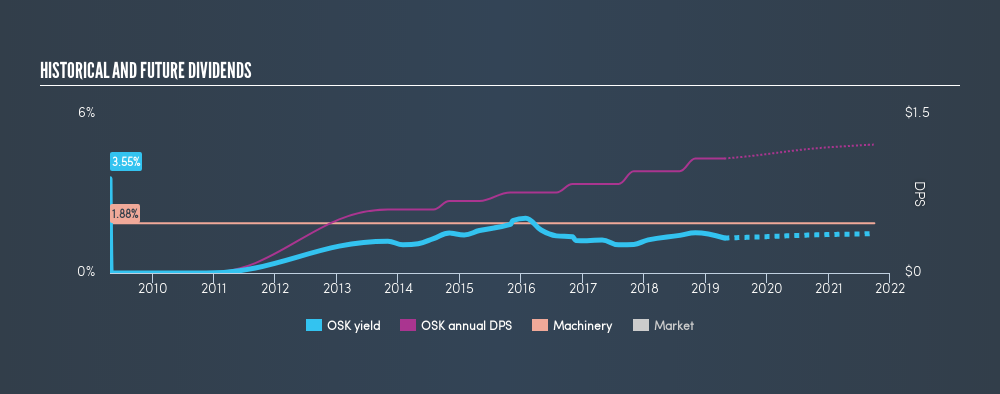
Is Oshkosh Corporation (NYSE:OSK) a good dividend stock? How would you know? A dividend paying company with growing earnings can be rewarding in the long term. Yet sometimes, investors buy a stock for its dividend and lose money because the share price falls by more than they earned in dividend payments.
A 1.3% yield is nothing to get excited about, but investors probably think the long payment history suggests Oshkosh has some staying power. It also bought back stock during the year, equivalent to approximately 6.2% of the company's market capitalisation at the time. Some simple analysis can offer a lot of insight when buying a company for its dividend, and we'll go through these below.
Click the interactive chart for our full dividend analysis
Payout ratios
Dividends are usually paid out of company earnings. If a company is paying more than it earns, then the dividend might become unsustainable - hardly an ideal situation. As a result, we should always investigate whether a company can afford its dividend, measured as a percentage of a company's net income after tax. Oshkosh paid out 14% of its profit as dividends, over the trailing twelve month period. We'd say its dividends are thoroughly covered by earnings.
Another important check we do is to see if the free cash flow generated is sufficient to pay the dividend. Of the levered free cash flow it generated last year, Oshkosh paid out 32% as dividends, suggesting the dividend is affordable.
We update our data on Oshkosh every 24 hours, so you can always get our latest analysis of its financial health, here.
Dividend Volatility
One of the major risks of relying on dividend income, is the potential for a company to struggle financially and cut its dividend. Not only is your income cut, but the value of your investment declines as well - nasty. Oshkosh has been paying dividends for a long time, but for the purpose of this analysis, we only examine the past 10 years of payments. During this period the dividend has been stable, which could imply the business could have relatively consistent earnings power. During the past ten-year period, the first annual payment was US$0.40 in 2009, compared to US$1.08 last year. Dividends per share have grown at approximately 10% per year over this time.
Dividend Growth Potential
Dividend payments have been consistent over the past few years, but we should always check if earnings per share (EPS) are growing, as this will help maintain the purchasing power of the dividend. Strong earnings per share (EPS) growth might encourage our interest in the company despite fluctuating dividends, which is why it's great to see Oshkosh has grown its earnings per share at 15% per annum over the past five years. Earnings per share are growing at a solid clip, and the payout ratio is low. We think this is an ideal combination in a dividend stock.
Conclusion
When we look at a dividend stock, we need to form a judgement on whether the dividend will grow, if the company is able to maintain it in a wide range of economic circumstances, and if the dividend payout is sustainable. It's great to see that Oshkosh is paying out a low percentage of its earnings and cash flow. We like that it has been delivering solid earnings growth and relatively consistent dividend payments. Overall, we think there are a lot of positives to Oshkosh from a dividend perspective.
Companies that are growing earnings tend to be the best dividend stocks over the long term. See what the 15 analysts we track are forecasting for Oshkosh for free with public analyst estimates for the company.
If you are a dividend investor, you might also want to look at our curated list of dividend stocks yielding above 3%.
We aim to bring you long-term focused research analysis driven by fundamental data. Note that our analysis may not factor in the latest price-sensitive company announcements or qualitative material.
If you spot an error that warrants correction, please contact the editor at editorial-team@simplywallst.com. This article by Simply Wall St is general in nature. It does not constitute a recommendation to buy or sell any stock, and does not take account of your objectives, or your financial situation. Simply Wall St has no position in the stocks mentioned. Thank you for reading.
About NYSE:OSK
Undervalued with excellent balance sheet and pays a dividend.
Similar Companies
Market Insights
Community Narratives



